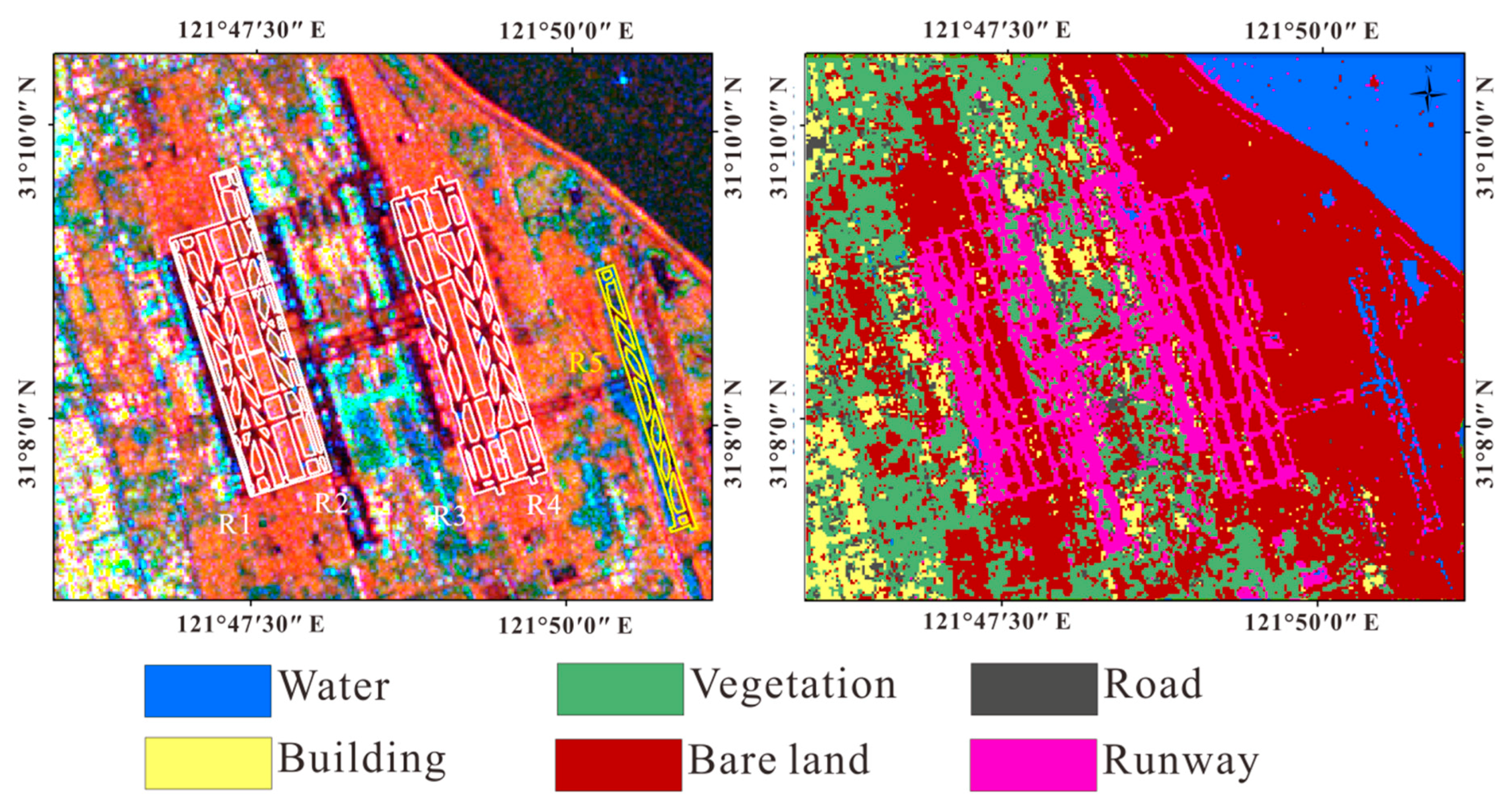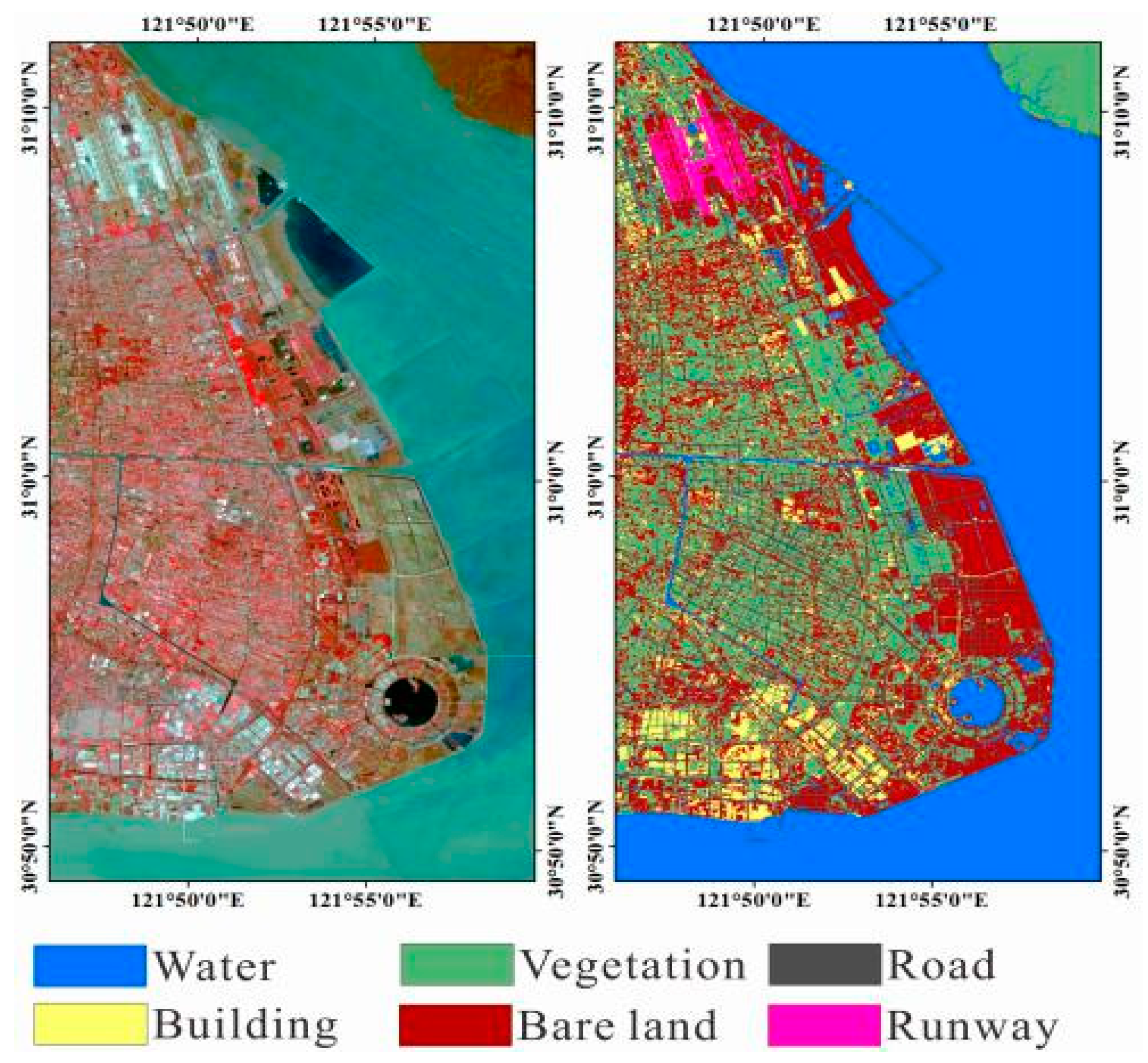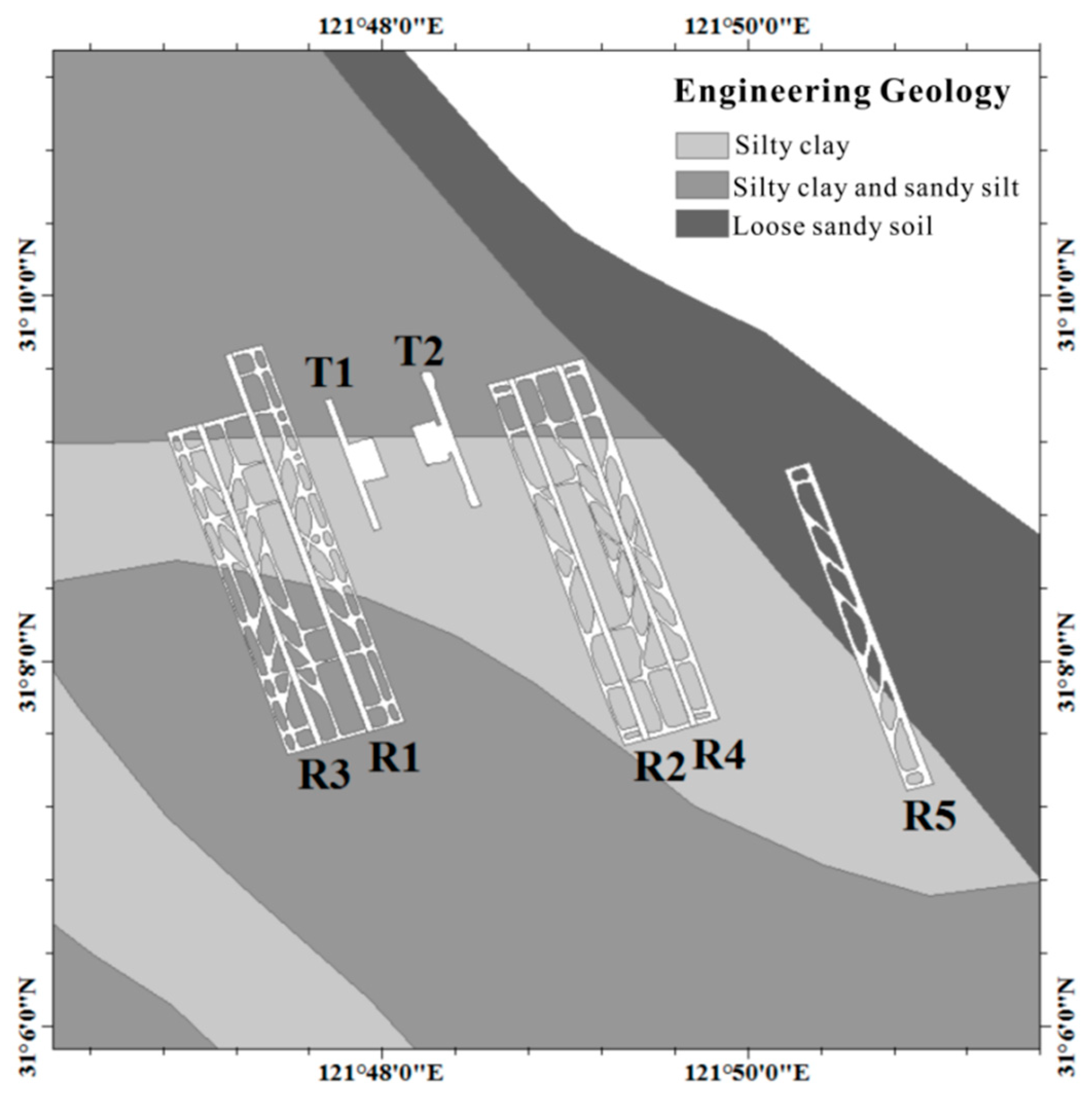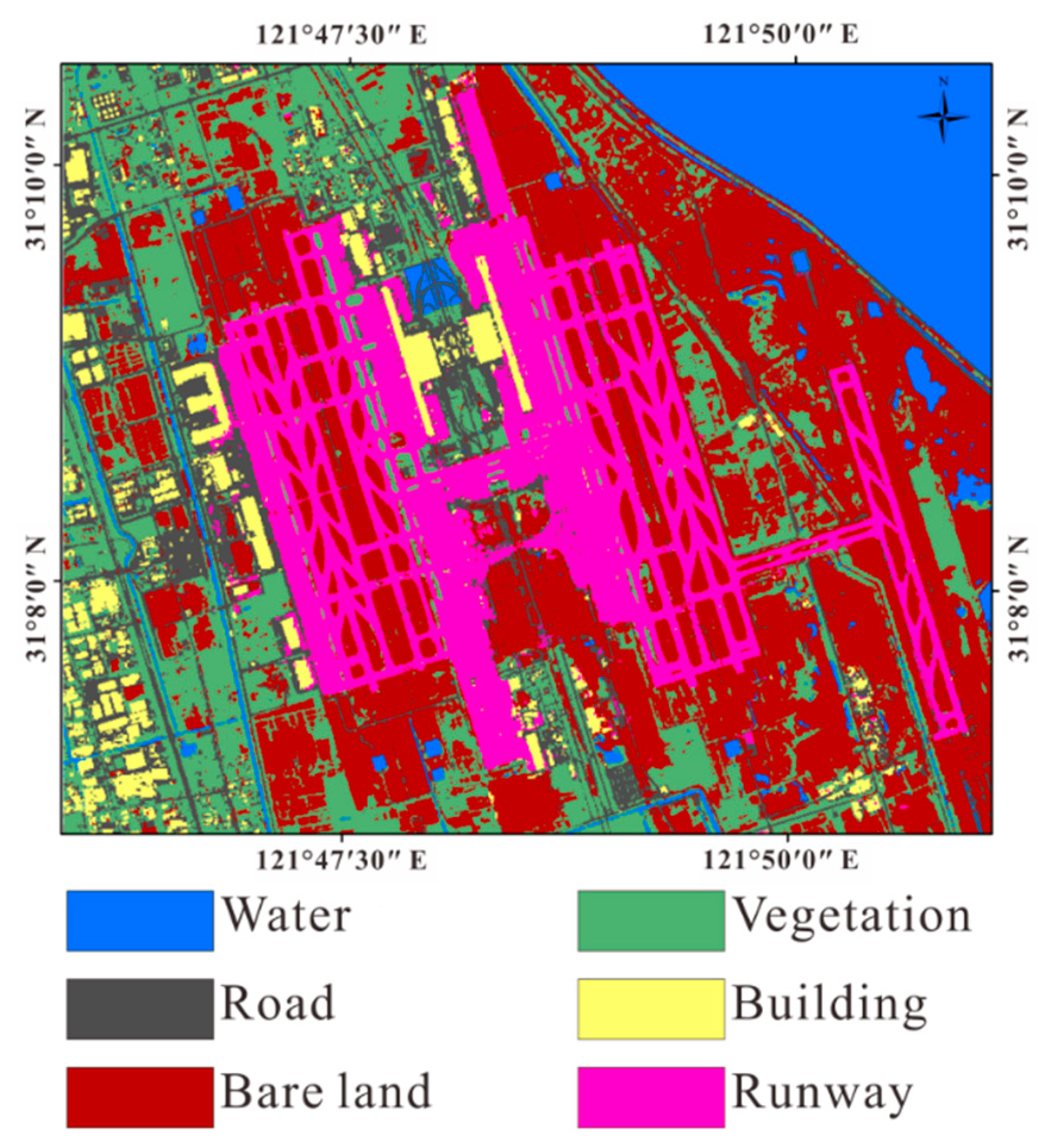3.1. Color Characteristics of Different Land Cover on Coherence False Color Images
We used two Sentinel-1A images (their acquisition dates are 27 February 2017 and 11 March 2017, respectively) from the 32 Sentinel-1A images data set. We firstly performed multi-look processing to reduce noise, the spatial resolution of the processed image is 30 m × 30 m. Then, the two images are used to get the coherence. The coherence (1st input) and two intensity images (2nd and 3rd input) were provided as input to output an RGB image. In the output RGB image, the Red channel is the coherence, the Green channel is the backscattering mean intensity, the Blue channel is the backscattering intensity difference (2nd–3rd).
From the coherence false color image, we can see the following features. Vegetation is usually cyan due to its large backscattering intensity difference. Artificial surfaces mostly appear white due to the high coherence and backscattering intensity. However, it is worth noting that it is obvious in the
Figure 2 there are two types of artificial surfaces that present a color that is quite different from most artificial surfaces. One of them is related to the ports. Due to the change of container placed on the port, the coherence is low. Due to the geometric characteristics of the container, the second-order angular reflection that has a strong echo signal is mostly generated, resulting in strong backscattering intensity [
39]. This caused a strong backscattering intensity, and the port shows light blue with extremely high brightness. Another is the airport, which is dark red due to low backscattering intensity and low backscattering intensity difference.
We selected samples of three kinds of land cover, port, airport and ordinary artificial surface respectively, and we used Jeffries-Matusita distance (J-M distance) as a parameter to show the separability. We compare the separability of the three kinds of land cover between the coherence false color image and true color optical image. The J-M distance between the ordinary artificial surfaces and the airport is 1.80, the J-M distance between the ordinary artificial surfaces and the port is 1.97, and the J-M distance between the airport and the port is 1.99 in the coherence false color image. In true color images, the J-M distance between ordinary artificial surfaces and the airport is 1.37. The distance between the ordinary artificial surfaces and the port is 0.58, and the J-M distance between the airport and the port is 1.56. The J-M distances in the coherence false color image of the three kinds of land cover are larger than the true color optical images. We can conclude that the coherence false color images are better at extracting ordinary artificial surfaces, ports, and airports.
It is noteworthy that we found that at the Pudong International Airport, the R5 runway showed completely different colors from other runways. The R5 runway is located in the reclamation area. We select the Support Vector Machine (SVM) algorithm to classify the coherence false color images. The SVM, first proposed by Vapnik in 1995 [
40], is a common identification algorithm. Many previous studies have demonstrated that the SVM algorithm has higher classification accuracy than traditional statistical and neural network algorithms. Salehi et al. found that the classification of the SVM algorithm is better than that of the multi-layer perceptive neural network [
14]. Zhang et al. found in the study that the SVM algorithm is superior to Fuzzy C-Means and multi-layer perceptive neural network methods both training speed and image classification accuracy [
41]. Based on MATLAB, we wrote SVM code to supervised classification. We selected the RBF kernel function, and get the optimal kernel function parameter width g = 0.5 and the penalty coefficient c = 128 by using grid search method. From the classification results (
Figure 3), we can see that the R5 runway was misclassified into the water, which is an unexpected error that should not appear in any research.
In the literature, it is well known that the coherence c can be factorized as the product of different contributions as follows:
where,
Ctemporal is temporal noise decorrelation,
Ctemporal is temporal decorrelation,
Cgeom is geometric decorrelation,
Cdoppler is Doppler centroid decorrelation,
Cprocessing is data processing decorrelation.
From Equation (11) we can see that coherence is influenced by several factors. The effect of thermal noise on coherence can be determined based on the signal to noise ratio (SNR) of the sensor. Doppler centroid decorrelation can be determined based on Doppler centroid frequency difference and azimuth bandwidth. Data processing decorrelation is mainly caused by registration errors. The decorrelation caused by these three factors affects the entire study area, and there is no difference on the data of thermal noise, Doppler centroid decorrelation, and data processing decorrelation between R5 and other runways.
Geometric decorrelation can be expressed as:
where,
B⊥,crit is the critical baseline,
B⊥ is the vertical baseline,
where,
α is the slope angle. From Equations (12) and (13), it can be seen that the slope angle has a greater influence on geometric decorrelation. When classifying by coherence, the influence of geometric decorrelation cannot be ignored. For example, the coherence in a flat region is higher than the undulating region with the same type of land cover. However, the land in the study area is flat, and the slope is unchanged. The geometric decorrelation affects the entire study area, and there is no difference between the R5 and other runways.
Temporal decorrelation is caused by changes in the physical and geometric properties of the scatterers during the acquisition time of two SAR images. Different land cover has different physical properties, which leads to different temporal decorrelation characteristics. Changes in surface roughness over time with different land cover also causes different temporal decorrelation. This is the basis for the use of coherence for land cover classification. However, the factors of temporal decorrelation are complex, and some factors that are not related to land cover may also cause temporal decorrelation in specific and partial regions. For example, severe deformation caused by earthquakes can also cause the coherence of the deformation region to decrease or even be completely decorrelation. This means that the coherence of a type of land cover in the deformation region is much lower than that of the region where no deformation occurs.
The same is true for the Shanghai reclamation area. Previous studies have shown that land subsidence occurs in this area [
29,
30,
31]. If this decorrelation is caused by surface deformation rather than by surface physical properties, it will cause classification errors. Therefore, we studied whether the ground deformation is the main reason for the R5 runway displays different colors, that is, whether this difference can be corrected if we remove the ground deformation signal.
3.3. Temporal Decorrelation Model
Considering that the coherence has obvious time-varying characteristics and richer information of multi-temporal coherence, we used multiple SAR images to obtain the relationship of coherence and temporal baseline. We construct the temporal decorrelation model of temporal baseline and mean coherence of each land cover type. Unless vegetation and bare lands will change with each other over time, the temporal decorrelation model cannot distinguish between vegetation and bare land. We hope that we can effectively distinguish roads and buildings, which are not correctly distinguished by multispectral images. Thus better results can be obtained in multi-source remote sensing classification.
We used the 32 Sentinel-1A data used in the previous SBAS algorithm, and the data acquired at 20,150,708 is the common master image, and the remaining 31 data are processed by the common master image respectively to obtain the coherence.
We have calculated the mean coherence of each type of land cover in the reclamation area (water is excluded because water can be easily distinguished between multi-spectral images and SAR intensities.) according to the previously defined deformation and stable area respectively. Considering some pixels there is serious noise interferes with the whole of the statistical results, we should exclude these pixels. We did the simple linear fitting for coherence time series of each pixel, and only include these pixels that linear fitting error is less than 1. Then we respectively calculated the mean coherence of each land cover type in stable area and reclamation area. Finally we obtained temporal decorrelation model of each land cover type.
We find that there is a large difference in the temporal decorrelation model of coherence between the deformed reclamation area and the stable western area. We can see that the stable area coherence temporal decorrelation model can better distinguish roads, buildings and other types of land cover. In the deformation area, roads, bare land, airports, vegetation cannot be distinguished, but roads and buildings are still able to be distinguished (
Figure 8).
We used Equation (11) to build the temporal decorrelation model. The fitting parameters are shown in
Table 3, and the fitting error are shown in
Table 4. From
Table 3 we can find that the mean
μ value of the building is 0.36, which is quite different from other land cover types and can be distinguished very well.
3.4. Include the Temporal Decorrelation Model into Multi-Source Remote Sensing Image Classification
We obtained a temporal decorrelation model for each pixel and calculated the Euclidean distances with the model of mean coherence of buildings. Using this distance and the model μ value as input data to assist multi-source remote sensing image classification. This method can better distinguish between buildings and roads, and reduce the misclassification of roads and buildings.
By way of comparison, we used the same method to classify Sentinel-2 multi-spectral images of true color and standard false-color composite images. Based on MATLAB, we wrote SVM code to supervised classification. We selected the RBF kernel function, and get the optimal kernel function parameter width g = 0.5 and the penalty coefficient c = 128 by using grid search method. The classification results are shown in
Figure 9:
Comparing the classification result with the visual interpretation result, the classification accuracy rate of the true color image is 64%, and the KAPPA coefficient is 0.53. The classification accuracy rate of the standard false color images is 75%, and the KAPPA coefficient is 0.68 (
Table 5 and
Table 6).
From the confusion matrix, we can see that the accuracy of classification for water is only 5%, which cannot identify the water. From the true color images and classification results, we can see that in the East China Sea, which occupies a most portion of water in the upper right part of the image. The true color image shows almost the same brown color as the bare soil due to the sediment concentration.
The accuracy of classification results of standard false color images is better than true color images. Among the classification result of standard false color images, the lowest accuracy is the road, with a correct rate of 38.01%. This is proved again while using multispectral remote sensing to classification, the roads are seriously misclassified as bare.
Compared with the classification results of the true color image, it can be seen that despite the overall accuracy of standard false color image classification results are higher than the true color image classification results, true color image classification accuracy is higher in roads and buildings. It can be seen that different bands and different types of sensors have different advantages for the classification. But both of them cannot distinguish between roads and buildings well. We need to introduce coherence information and temporal decorrelation model into multi-source remote sensing land cover classification.
We used the parameters of temporal decorrelation model, coherence data, SAR backscattering intensity data and four bands of Sentinel-2 (red, green, blue and near infrared band) as input data, and used SVM to supervised classification, because SVM has a high popularization ability for high-dimensional input vectors. The classification results is shown in
Figure 10.
By comparing the classification result with the visual interpretation result, the classification accuracy rate is 86%, and the KAPPA coefficient is 0.82. Among them, the accuracy rate of the airport is as high as 93%, which can be used to identify the airport well (
Table 7). Compared with the classification results of true color images and standard false color images, the overall accuracy rate increased by 22%, 11%, KAPPA coefficient increased by 0.29, 0.14 respectively.
Multi-source remote sensing fusion can greatly improve the classification accuracy. Using the temporal decorrelation model in multi-source remote sensing land cover classification can greatly improve the recognition rate of buildings and roads.















